
* In the 1930s, the Beech Aircraft Company of Wichita, Kansas, introduced a four-seat luxury private aircraft, the "Model 17" -- an elegant biplane with an unusual wing arrangement that made it known as the "Staggerwing". It proved popular, with hundreds being obtained by the US military during World War II for utility / liaison work.
After the war, the company introduced a more modern four-seat private aircraft, the "Model 35 Bonanza", with an unconventional vee tail. It proved very popular, being followed by "Model 33" with a conventional tail arrangement, and then a stretched Model 33, the "Model 36" -- which remains in production in the 21st century. This document provides a history and description of the Beech Staggerwing and Bonanza -- along with the Beech "Musketeer" and "Skipper". A list of illustration credits is included at the end.
* Walter H. Beech had been a US Army aviator during the First World War. After the conflict, he remained in the aviation sector -- starting out as a test pilot, to then help establish the Travel Air Aircraft Company. Travel Air was bought out by the Curtiss-Wright Corporation in 1929, with Beech becoming a company vice-president. In 1932, he left Curtiss-Wright to found the Beech Aircraft Company, sited in Wichita, Kansas.
Beech, working with designer Ted Wells, developed the "Model 17" -- the number following the last Travel Air design, the Curtiss-Wright CW-16. The Model 17 was a four-seat biplane, intended primarily as an executive transport, with an eye towards competing in the civil market then dominated by the Waco aircraft company. Initial flight was on 4 November 1932.

Three initial configurations were built:
These "A-series" machines -- lumping the Model 17R in with them for convenience -- had very good performance for the era, but their handling left something to be desired, and they were too expensive. A comprehensive redesign led to the "Model B17L", first flying in 1934, with two built. The B17L was powered by a Jacobs L-4 / R-755D 7-cylinder air-cooled radial engine providing 165 kW (225 HP). The most noticeable difference from the A-series was the landing gear. While the A-series had fixed landing gear -- more than less, the mainwheels could tuck up into the bottom of the "pants" fairings -- the B17L had retractable landing gear, with a wider and more manageable track than the A-Series. The B17L became the basis for initial full production.
The B17L provided a baseline for the family. It was a biplane of taildragger configuration and mixed construction, with fabric over a steel tube frame with wooden fittings -- plus tailfin and tailplane of wood construction, though the elevators and rudder were made of fabric-covered steel tubing. There were single-piece flaps and ailerons on the lower wing. All the flight controls were manually actuated. The wing configuration was unusual, with the lower wing forward of the upper wing -- the two connected by a raked "I"-type strut outboard, and crisscross dual cabling inboard.
A number of reasons have been advanced for the "negative stagger" wing, as the company called it: better field of view forward, improved handling, stabler positioning of the landing gear. It was certainly a plus for looks, giving an impression of speed. In any case, the wing gave the aircraft the name it would be famous for: "Staggerwing" -- though it was never an official name.
The engine turned a two-bladed propeller. Early Staggerwings had a fixed-pitch wooden prop, later had a variable-pitch Hamilton Standard type, though sources hint that Hartzell props might have been fitted as well. The main landing gear pivoted from the wings in towards the fuselage; the tailwheel was retractable. There are photos of Staggerwings with floats, but that appears to have been an unusual fit. There were twin bucket seats up front, and a bench seat across the back -- the bench seat able to handle two ordinary-sized people or, say, one adult and two kids. The only way in or out was through a forward-hinged door on the left, opening into the rear of the cockpit. Accommodations were luxurious, Beech targeting the wealthy as customers for the Staggerwing.
BACK_TO_TOP* The engine fit for Staggerwing variants was given by a letter suffix -- "B17B", "B17E", and so on. The Staggerwing had ten different engine fits through its lifetime, all 7-cylinder (7C) or 9-cylinder (9C) air-cooled radials, built by Wright, Jacobs, or Pratt & Whitney (PW):
There were four B-series variants, identical except for engine:
That gave total B-series Staggerwing production of 67 machines into 1936 -- when it was replaced in production by the C-series, which was much the same as the B-series, except for various tweaks. Engine fits of the C-series were the same as for the B-series:
That gave total production of C-series Staggerwings as 84 machines. The Staggerwing had excellent performance, particularly the "R" series with the high-rated Whirlwind engine, and participated in air races. Louise Thaden and Blanche Noyes won the 1936 Bendix trophy in a C17R.
The C-series gave way to the definitive "D-series" in 1937. It was substantially redesigned from the C-series, with a lengthened fuselage to improve yaw handling, and the ailerons moved to the upper wing, the flaps remaining on the bottom -- the flaps had impaired aileron authority. D-series variants included:
That gave total production of civil D-series Staggerwings as 104 machines. The D17S was also the basis for military production in World War II, see below.

The D17W, it appears, was intended as an air racer, one being flown by the well-known aviator Jacqueline Cochran, who used it to win the Women's Division in the 1937 Bendix race, and also used it to set a women's speed record. This particular machine became the UC-43K.
___________________________________________________________________
BEECH D17S STAGGERWING:
___________________________________________________________________
wingspan:
9.75 meters (32 feet)
wing area:
27.55 sq_meters (296.5 sq_feet)
length:
8.18 meters (26 feet 10 inches)
height:
2.44 meters (8 feet)
empty weight:
1,150 kilograms (2,540 pounds)
normal loaded weight:
1,930 kilograms (4,250 pounds)
max speed:
340 KPH (210 MPH / 340 KT)
cruise speed:
325 KPH (200 MPH / 175 KT)
service ceiling:
7,600 meters (25,000 feet)
range:
1,075 kilometers (670 MI / 580 NMI)
___________________________________________________________________
The "E-Series" and "F-series" were built in parallel with the D-series, and apparently were lower-cost variants, with the cheaper Jacobs radials. They included:
With war flaming in Europe, in 1940 the US Army Air Forces (USAAF) obtained three Model D17S machines for evaluation, these aircraft being designated "YC-43 Traveler"; the US Navy obtained ten similar preliminary "GB-1" machines. That led to procurement of 412 "UC-43 / GB-2" Staggerwings for the US military -- the breakdown being roughly 231 UC-43s and 181 GB-2s. The only noticeable difference between the civilian D17S and its military siblings was that the military machines had a direction-finding loop antenna on the belly. In any case, total production of the Staggerwing is given as 785 aircraft.
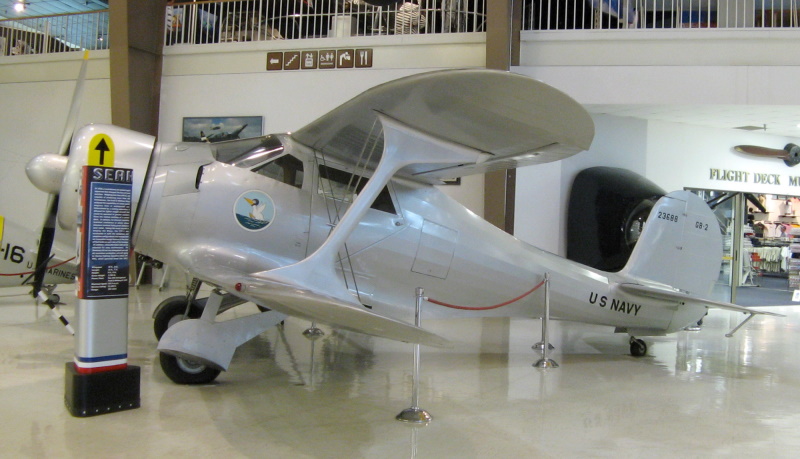
Exact breakdown of the relative numbers of Staggerwings built for each of the two services is hard to grasp -- since in a good number of cases, machines built for one service were obtained by the other, and there was considerable swapping of machines in service. 106 of the machines built for US service also ended up in British hands under Lend-Lease, with the British designation of "Traveller Mark I". In any case, the military Staggerwings were used as VIP transport, liaison, and utility machines.
The British Staggerwings were either returned or scrapped at the end of the war. US military Staggerwings lingered in service for a time after the war, to then either be scrapped, passed into civil service, or provided to US allies. Countries that flew the Staggerwing in military service beyond the US and Britain included Australia, Bolivia, Brazil, China, Cuba, Ethiopia, Finland, Honduras, the Netherlands, New Zealand, Peru, the Spanish Republic, and Uruguay -- with a number of these users flying different Staggerwing variants derived from civil Beech production, instead of hand-me-down US military machines. The Spanish Republicans flew theirs as bombers during the civil war.
After the end of the conflict, Beech threw together a final batch of "G17S" Staggerwings with various refinements, ending Staggerwing production with a total of 785 aircraft delivered. A large number of Staggerwings survive, including many flying examples -- refurbished Staggerwings, in some cases including a bit of modernized avionics, being seen as a prestige mount. The Staggerwing is a flying equivalent of a classic 1930s roadster, and priced in much the same way.
BACK_TO_TOP* As World War II drew to a close, US aircraft manufacturers looked forward to a revival of civil aviation -- indeed, they had expectations of a wild boom of Americans buying private aircraft. Beech designer Ralph Harmon decided to come up with a new four-seat civil aircraft design, using aircraft technology that had come of age during the war. According to legend, Harmon proposed the concept to Walter Beech, who was unenthusiastic; Harmon worked on the design at home in his spare time, and managed to convince Beech to make it real. The first flight of the "Model 35 Bonanza" was on 22 December 1945, with customer deliveries in 1947.
The Bonanza was a departure from prewar light civil aircraft design, more reminiscent of World War II fighter aircraft. It was a low-wing aircraft with tricycle landing gear, and of all-metal construction -- except for fabric-covered flaps and ailerons in the earliest production, with magnesium covering introduced later. It was distinctive in having a vee tail. The Model 35 was powered by a Continental E-185-1 engine flat-six air-cooled engine with 125 kW (165 HP), driving a two-blade wooden variable-pitch propeller. The Bonanza was much cheaper than the Staggerwing, the Model 35 having been designed to be much simpler to manufacture.

The wing flight control surfaces were conventional -- flaps and ailerons -- with the vee tail having a combined "ruddervator" surface on each fin. All the flight control surfaces were manually actuated; the rudders and yoke were linked by bungee cords to assist turns. The landing gear retracted manually, all assemblies with single wheels, the castoring nose wheel retracting backward, the main gear retracting from the wings in towards the fuselage. Ground steering was by differential braking.
A scheme was implemented to make sure the landing gear couldn't be retracted on the ground. Access was through a single front-hinged door on the front right; there was a small cargo door on the rear right, baggage being stowed behind the rear seats. There were two windows on each side of the fuselage, and four seats, with two bucket seats up front and a bench seat in the rear. It didn't have dual controls, at least by default, but the control yoke could be swung from one seat to the other. The aircraft was unpressurized.
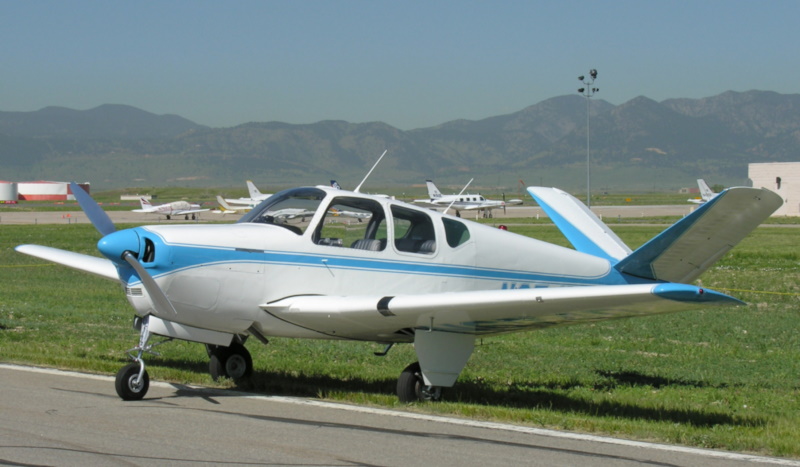
The Model 35 would prove wildly successful; while the postwar private aviation boom expected by US aircraft manufacturers didn't generally materialize, Beech hit the "sweet spot" of the market that did emerge. The company was a bit of a victim of its own success: the Beech 35 ended up with a high accident rate, to become known as the "vee-tailed doctor killer". There may have been some technical difficulties early on, but the most common problem was overly confident pilots -- stereotypically doctors, inclined to think their skills as doctors necessarily carried over to piloting -- flying them into storm clouds.
1,500 Model 35 Bonanzas, retrospectively known as the "Straight 35", were built. Refinements followed:
A second-generation Model 35, the "H35", was introduced in 1957. The H35 featured a stronger airframe plus updated interior -- as well as a Continental 0-470-G engine with 180 kW (240 HP), driving a constant-speed prop. 464 H35s were built in 1957, to be followed by improved variants:
A third generation of Model 35, the "S35" was introduced in 1964, the significant changes being:
667 S35s were built in 1964 and 1965. The S35 was the starting point for the very last vee-tailed Bonanza series, starting with the "V35" -- which was an S35 with still higher MTOW and a one-piece windscreen. The V35 could be obtained as the "V35-TC", with a turbocharged TSIO-520-D engine, allowing it to maintain performance at altitude. Oxygen systems and prop de-icing were popular options. 873 V35s & V35-TCs were built in 1966 and 1967.
A "V35A" followed, being a V35 with a larger and streamlined windscreen, plus various tweaks. It could be obtained as the turbocharged "V35A-TC". 470 V35s were built in 1968 and 1969. The ultimate vee-tail Bonanza was the "V35B", featuring refinements in systems and trim, with a 24-volt electrical system in later production. It could be obtained as the turbocharged "V35B-TC". 873 were built from 1970 to 1982.
___________________________________________________________________
BEECH V35B BONANZA:
___________________________________________________________________
wingspan:
10.21 meters (33 feet 6 inches)
wing area:
16.81 sq_meters (181 sq_feet)
length:
8.05 meters (26 feet 6 inches)
height:
2.31 meters (7 feet 7 inches)
empty weight:
960 kilograms (2,115 pounds)
MTO weight:
1,540 kilograms (3,400 pounds)
max speed at sea level:
335 KPH (210 MPH / 180 KT)
cruise speed:
320 KPH (200 MPH / 170 KT)
service ceiling:
5,450 meters (17,800 feet)
range:
1,650 kilometers (1,025 MI / 890 MI)
___________________________________________________________________
Bonanzas could be obtained with special kit, such as dual controls for training, or wingtip tanks. It is unclear if such kit was available from factory production, aftermarket suppliers, or (probably) both. Some vee-tail Bonanzas still flying have been fitted with modern avionics modules. The V35B was the end of the road for the vee-tail Bonanzas, but that wasn't the end of the Bonanza by any means.
BACK_TO_TOP* It appears the Model 35 Bonanza never really shook the "vee-tailed doctor killer" name. More to the point some buyers, particularly conservative government buyers, were put off by the vee tail -- and so in 1959, Beech introduced what amounted to an M35 Bonanza with a conventional tail assembly, which was introduced as the "Model 33 Debonair" -- the new name of course intended to further differentiate the new aircraft from the vee-tails. It seems that early on, it was actually known as "Model 35-33", but that distinction is ignored here. Much was also done to the Model 33 to reduce costs, in hopes of matching competition from Piper and Cessna.
The Model 33 was powered by a Continental IO-470-J fuel-injected flat-six engine with 165 kW (225 HP). The baseline model was very spartan, with an austere interior, customers supposedly buying options to bring it up to snuff. 233 Model 33s were built in 1959, to be followed by improved variants:
There was a "D33 Debonair", but it was a one-off prototype of a light attack aircraft, and is discussed below.
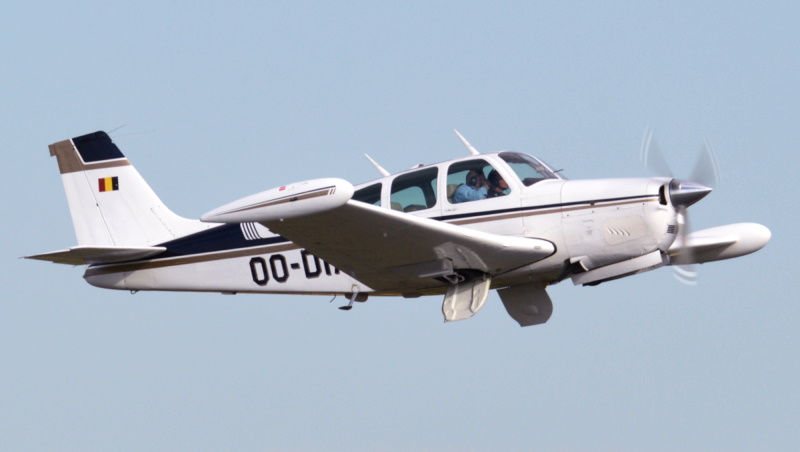
In any case, with the C33A effectively up to much the same standard as contemporary vee-tailed Bonanzas, the company gave up the attempt at product differentiation -- and so the next model, the "E33", was simply called a "Bonanza". It was much the same as the C33, with the IO-470-J engine, but with a proper standard of trim -- the large rear window being standard -- with 116 built in 1968 and 1969.
An "E33A" with the IO-520-B flat-six engine was built in parallel, with 85 built in 1968. There was also an "E33B", which was the E33 with a reinforced airframe and certified for aerobatics; it is unclear how many were built, and they may have been part of E33 production. The "E33C" was an E33B aerobatic machine with the IO-520-B flat-six engine, with 25 built in 1968 and 1969.
The "F33" was a minor update of the E33, with the IO-470-J engine, modified rear side windows and other tweaks, with 20 built in 1970. It gave way to the "F33A", with the more powerful IO-520-B flat-six engine, with 621 built from 1970 through 1994. Later production had the stretched fuselage and six seats. 118 "F33C" Bonanzas -- same as the F33A, but certified for aerobatics -- were built in 1970. The final Model 33 variant was the "G33", which was an F33 with a Continental IO-470-N engine providing 195 kW (260 HP) and V35B trim, with 50 built in 1972.
* As an evolution of the Model 33, in 1968 Beech introduced the "Model 36 Bonanza", which featured a fuselage stretch of 25 centimeters (10 inches), giving room for six proper seats, with double doors on the rear right fuselage. Two seats could be removed and two folded for cargo carriage. Later production had club-type seating, with two rows of facing seats and a folding tabletop. It is not clear if three forward-facing rows of seats were ever offered. The Model 36 could be configured as an air ambulance, with space for one stretcher and seating for a medical attendant. Baggage space was limited in early production, but eventually more room was found behind the rear seats. The double doors were apparently also available as an option on long-cabin Model 35 and Model 33 Bonanzas.
___________________________________________________________________
BEECH MODEL 36 BONANZA:
___________________________________________________________________
wingspan:
10.21 meters (33 feet 6 inches)
wing area:
16.81 sq_meters (181 sq_feet)
length:
8.38 meters (26 feet 6 inches)
height:
2.62 meters (8 feet 7 inches)
empty weight:
1,148 kilograms (2,530 pounds)
MTO weight:
1,655 kilograms (3,650 pounds)
max speed at sea level:
340 KPH (215 MPH / 185 KT)
cruise speed:
305 KPH (190 MPH / 165 KT)
service ceiling:
5,640 meters (18,500 feet)
range:
1,385 kilometers (860 MI / 745 NMI)
___________________________________________________________________
Six full-sized passengers could not be carried along with a full fuel load. The Model 36 was easily identified by having four cabin windows on each side of the fuselage. It was powered by the Continental IO-520-B flat-six engine. 184 were built in 1968 and 1969.

Improved variants followed:
The final production version of the Bonanza was the "G36", which was an A36 with a Garmin glass cockpit, introduced in 2006. An update with a fully revised interior and modernized climate-control system was introduced in 2012. The G36 is still in limited production. Almost 18,000 Bonanzas have been produced, the majority of them still flying.
BACK_TO_TOP* The Bonanza ended up serving in the military forces of several nations, including Iran, Mexico, the Netherlands, and Spain, in the utility or flight training roles. The "D33 Debonair", mentioned above, was a light attack derivative of the Debonair, featuring three stores pylons under each wing for rocket pods, light bombs, or machine guns, with evaluation by the US Air Force from 1965. This machine was then more generally improved by re-engining it with a Continental GIO-520 flat-six engine providing 260 kW (350 HP), driving a three-bladed prop, with the aircraft being painted in "jungle fighter" camouflage at one point. It was then known as the "PD 249" AKA "YAU-22A". The USAF abandoned the effort in the early 1970s.
The Bonanza did see action of sorts over Southeast Asia during the Vietnam War in the form of the "QU-22", which was a militarized Model 33, intended to be used by the US Air Force as a relay aircraft for the PAVE EAGLE program, passing on signals from ground sensors air-dropped on the Ho Chi Minh Trail in Laos and Cambodia, to track North Vietnamese supply and infiltration columns moving along the trail.
Six "YQU-22A" prototypes were operationally evaluated in 1968, with two lost, a civilian test pilot being killed. That led to 27 "QU-22Bs" that went into operational service, with six lost, two Air Force pilots being killed. The QU-22Bs had airframe reinforcement and more fuel supply for greater endurance; they had a distinctive "hump" on the nose. Sources are confusing on the hump, some saying it was for reduction gear to reduce prop RPM and noise, others that it contained an electric generator to drive the relay payload; it may have been both. They could in principle be flown as drones, but they were always piloted in operational service. It appears that all the losses were from mishaps, not enemy fire.
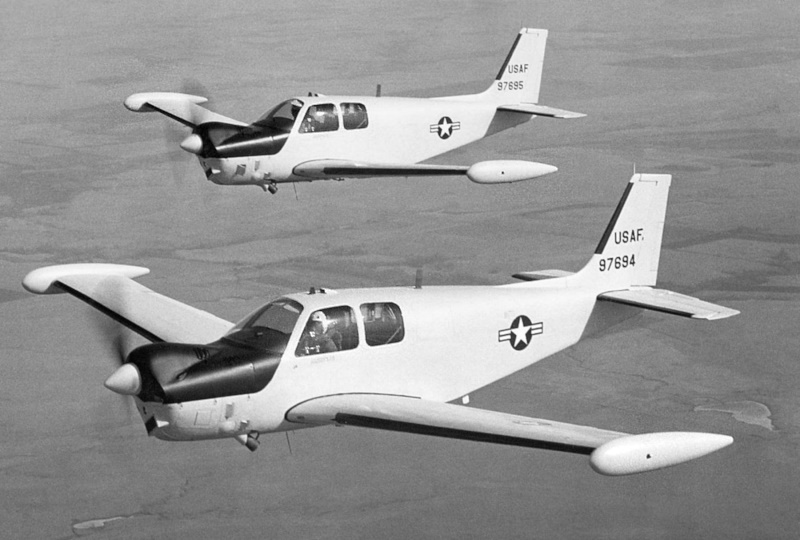
* There were a number of special modifications of Bonanzas, likely the oddest being the Beech Model 40A, with a single prototype built in 1948. It featured two Franklin flat-four engines in an over / under arrangement, driving a single prop. The idea ran into complications -- it turned out that certification required a firewall -- and was a dead end. Although "Twin Pac" turboprops are nothing unusual today, the configuration didn't work so well for piston engines.
Since that time, there have been a number of re-engining programs for Bonanzas, including refits of alternative flat-piston powerplants, or turboprop propulsion -- including the Allison 250 or Pratt & Whitney PT6A. There was also the "Bay Super V", which was a twin-piston conversion of the Bonanza. The Bonanza did lead to twin-engine aircraft designs produced by Beech, but that's a devious subject best discussed elsewhere.
BACK_TO_TOP* Outside of the Staggerwing and Bonanza / Debonaire, Beech primarily focused on twin-engine instead of single-engine civil aircraft -- but the company did produce two other singles, the "Musketeer" and the "Skipper".
The prototype for the "Model 23 Musketeer" performed its initial flight on 23 October 1961, with initial deliveries late in 1962. It had a general configuration not so different from later models of the Bonanza, being a low-wing all-metal aircraft -- with elements made of aluminum honeycomb --with a conventional flight-surface arrangement -- but it was smaller, with a Lycoming O-320-D2B flat-four air-cooled engine providing 120 kW (160 HP) driving a two-bladed fixed prop, and had fixed tricycle trailing-link landing gear.
It had two windows on each side, and seats for four with baggage space behind the rear seats -- entry being via a front-hinged door on the right side of the fuselage. An additional left-side door was an option. Single controls were standard, though a dual-control option was offered during the product's evolution. There was a mounting step behind the wing on the right, and a baggage door above that. 553 were built through 1963.
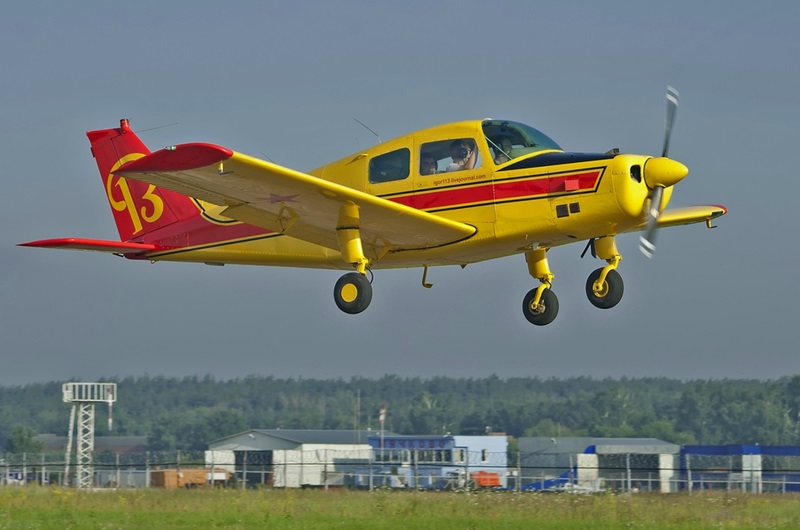
The "A23 Musketeer II" was introduced in 1964; it featured three windows on each side, and a Continental IO-346-A fuel-injected flat-four engine with 125 kW (165 HP). 346 were built -- to be followed by the "A23A Musketeer III" series in 1965, which was offered in three different configurations:
___________________________________________________________________
BEECH A23A CUSTOM:
___________________________________________________________________
wingspan:
9.98 meters (32 feet 9 inches)
wing area:
13.6 sq_meters (146 sq_feet)
length:
7.82 meters (25 feet 8 inches)
height:
2.51 meters (8 feet 3 inches)
empty weight:
625 kilograms (1,375 pounds)
normal loaded weight:
1,090 kilograms (2,400 pounds)
max speed:
235 KPH (145 MPH / 125 KT)
cruise speed:
190 KPH (115 MPH / 100 KT)
service ceiling:
4,000 meters (13,000 feet)
range:
1,250 kilometers (780 MI / 675 NMI)
___________________________________________________________________
These three lines of aircraft then went through confusing reshufflings:
It should be noted that the Model 23 line was developed into a piston twin, the Beech "Duchess", but that is outside of the range of this document. The Royal Canadian Air Force obtained 24 B23 Musketeer IIs for training as the "CT-134", much later replacing them with 24 C23 Sundowners, designated the "CT-134A". Mexico also obtained 20 Model 19 trainers.
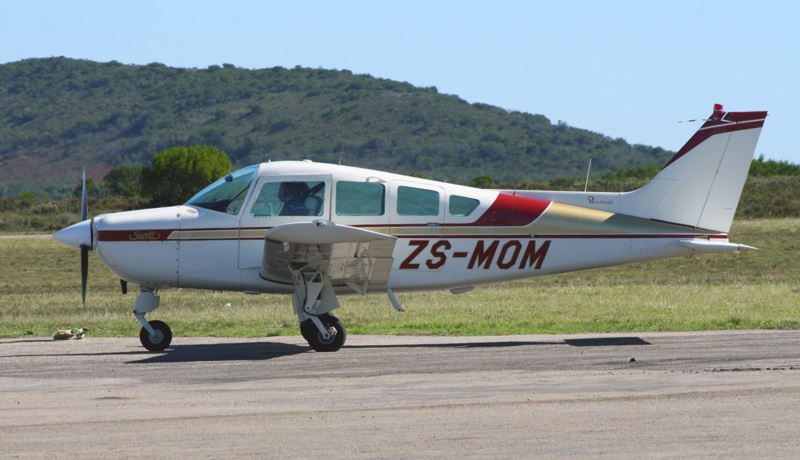
Production of the Model 19 Sport series ended in 1979, while production of the Model 23 Sundowner and Model 24 Sierra series ended in 1983. Total production of the Musketeer line is given as 4,366 aircraft; trying to nail down the numbers for individual product lines is an exercise in frustration.
* The Beechcraft "Model 77 Skipper" had a much less convoluted history than that of the Musketeer line. It began life as a two-seat low-maintenance trainer, with the prototype of the "PD 285", as it was referred to then, performing its first flight on 6 February 1975. Customer shipments began in 1979.
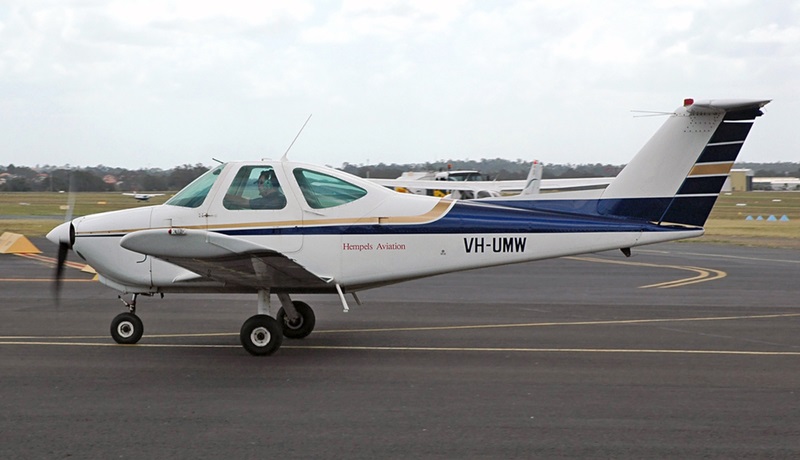
The Skipper was a low-wing all-metal aircraft with fixed tricycle landing gear, rectangular wings with a prominent dihedral, a swept tailfin, and a rectangular tee tailplane. It was powered by a Lycoming O-235-L2C flat-4 engine with 86 kw (115 HP). Control surface arrangement was conventional, though the control surfaces were actuated by torque tubes, not cables. It had a side-by-side cockpit, with front-hinged doors on each side. The Skipper was very similar to and competed with the Piper PA-38 Tomahawk.
___________________________________________________________________
BEECH MODEL 77 SKIPPER:
___________________________________________________________________
wingspan:
9.14 meters (30 feet)
wing area:
12.1 sq_meters (129.8 sq_feet)
length:
7.32 meters (24 feet)
height:
2.41 meters (7 feet 11 inches)
empty weight:
1,100 kilograms (1,100 pounds)
max take-off weight:
769 kilograms (1,675 pounds)
cruise speed:
195 KPH (120 MPH / 105 KT)
service ceiling:
3,030 meters (12,900 feet)
range:
765 kilometers (475 MI / 410 NMI)
___________________________________________________________________
Most early production was sent to the Beech Aero Centers, which were Beechcraft's flight training centers. Although the Tomahawk had slightly better performance, the Skipper was roomy and handled well. The Skipper was introduced right at the start of a downturn in the market for general aviation aircraft, As a result, production ended in 1983 after modest production of 312 aircraft.
BACK_TO_TOP* There isn't that much data on the Bonanza out there, so this document was put together as a scavenger hunt from websites and various air encyclopedias. One source, however, did prove valuable:

* Illustrations credits:
* Revision history:
v1.0.0 / 01 mar 18 v1.1.0 / 01 feb 20 / General update. v1.1.1 / 01 dec 21 / Review & polish. v1.1.2 / 01 feb 23 / Review & polish. v1.1.3 / 01 dec 23 / Review & polish. (++)BACK_TO_TOP
